Hot Takes from the HOTSAUCE Tech Conference
As the digital world continues to expand and transform at breakneck speed, it’s not just about keeping up anymore — it’s about leading the way. This year HOTSAUCE, the first event hosted by Hotjar, set the stage for a series of illuminating discussions, revealing insights into the future of technology, design, product development, and growth
As an attendee, I was thrilled to be a part of this remarkable gathering, buzzing with innovators, thought leaders, and change-makers. Although I couldn’t possibly cover all the ground-breaking talks and workshops, I’ve gathered some highlights and musings from a selection of some of the great speakers who shared their expertise and visions for navigating this new era
From Mohannad Ali’s roadmap for digital disruption to Ioana Teleanu’s exploration of AI in UX, each segment offered a unique lens on the challenges and opportunities ahead. Ghazal Badiozamani prompted us to reflect on the generative AI tools reshaping our work, while Ramli John and Kevan Lee painted a picture of how content, brand, and creativity can propel businesses forward. And, of course, Kyle Poyar’s session reminded us that sometimes, the most dynamic tools for growth—like pricing and packaging—are already within our grasp
It was an electrifying couple of days, where every conversation and every corridor turn brought a new idea or a new perspective.
Navigating the Next Era of Digital Technology with Mohannad Ali
Kicking us off for the day, Mohannad Ali, the dynamic CEO of Hotjar, took to the HOTSAUCE stage to deliver a compelling perspective on the digital landscape. His keynote, Navigating the Next Era of Digital Technology, was all about embracing the digital renaissance, underscored by a crucial element often missing from the tech equation: empathy.
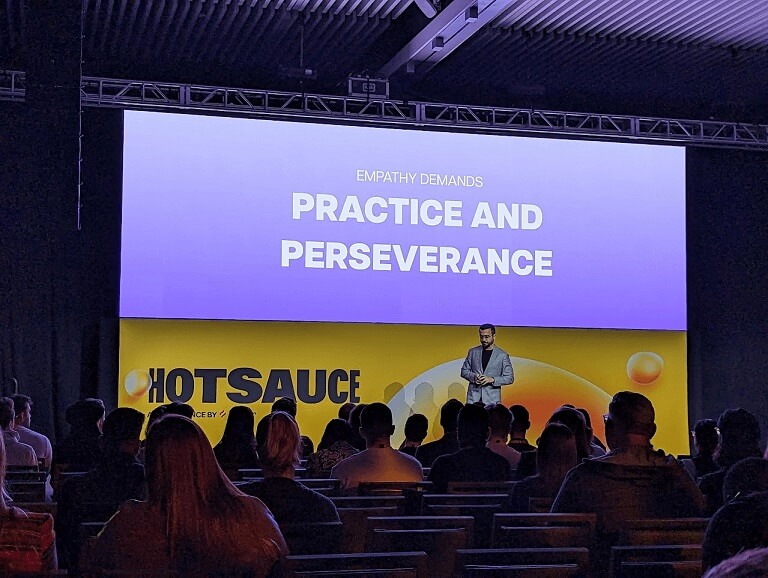
Mohannad’s message was clear: The digital world is in the throes of a major transformation, one that’s been catalyzed by the Covid-19 pandemic. He pointed out it has sped up the shift to e-commerce by five years, adding an unexpected $200 billion in sales. Mohannad distilled this sea change for the HOTSAUCE audience into four vital considerations for anyone navigating this new era:
Seamless experiences as a staple
Slow or confusing online experiences are deal-breakers, leading to lost sales and a shift in customer loyalty. Businesses can’t afford to skimp on smooth digital interactions.
Mohannad shared some striking figures: a staggering 75% of consumers will abandon a purchase if they’re faced with slow-loading pages or a confusing checkout process. Even more telling is that 84% would rather switch to a competitor than deal with a website that’s hard to navigate.
Values as consumer magnets
Consumers are increasingly choosing brands that resonate with their personal beliefs. Mohannad emphasized that a brand’s stance on issues could make or break its connection with its audience. It’s not just about price or convenience anymore. For 60% of consumers, the alignment of a brand with their personal values sways their buying choices.
Mohannad didn’t just share these statistics; he also painted a broader stroke on the importance of brand positioning, noting that for many, especially 24% of Gen Z, there’s a readiness to boycott brands that don’t align with their social and political beliefs.
The power of personalization
Mohannad then turned to the lucrative side of personalization. He pointed out the significant impact it has on the bottom line, as businesses report seeing over a 40% uptick in revenue when they get personalization right. Tailoring customer experiences can significantly boost business revenue. For Mohannad, personalization is not just a strategy, it’s the future of customer engagement.
The human touch in AI
He addressed the common fears around AI, sharing that while 69% of companies now have AI-driven products in production, there’s comfort in the statistic that 50% of users are comfortable with AI integration. This, Mohannad stressed, should be viewed as an opportunity to enrich user experiences rather than a move to replace the human touch
Throughout his talk, Mohannad returned to one core message: the power of empathy. It’s about putting ourselves in the shoes of the customer, he suggested, to transform digital interactions into more meaningful human experiences
Tackling the topic of loneliness, he referenced the broader societal challenge we face, where despite the rise of online workouts, streaming services, and grocery deliveries, there’s a shadow cast over authentic human interaction
Finally, Mohannad spoke candidly about the need for empathy in the workplace, especially during challenging times. He shared his approach at Hotjar, where openness, inclusive dialogue, and a collective sense of responsibility have been crucial
Mohannad’s keynote was a powerful reminder that in the end, tech is about people. His parting advice? Lean into empathy. It’s what turns a user into a community member, a customer into a brand advocate.
Mohannad’s call for a deeper human connection within the digital realm naturally segued into another facet of the user experience: artificial intelligence. As the first day of the HOTSAUCE conference progressed, the conversation shifted from the abstract art of empathy to the concrete science of AI. But even here, in the binary world of algorithms and data patterns, the human element remained pivotal.
From Worry to Wow: Crafting AI-Powered Experiences with Ioana Teleanu
Ioana Teleanu, the Lead Product Designer for AI at Miro, stepped onto the stage with a promise to demystify AI and reveal how it can enrich user experience. Her session, titled From Worry to Wow: Crafting AI-Powered Experiences was a masterclass on the intersection of AI and product design
Ioana emphasized that the discussions we engage in today about AI are laying the groundwork for the future of product design. She urged the HOTSAUCE audience to calibrate AI principles ethically and responsibly, setting the stage for better outcomes. Ioana pointed out that it’s not about fearing AI, but rather about understanding its limitations and potential, ensuring that AI’s applications are guided by clear, ethical boundaries
Highlighting the incredible adoption curve of technologies like ChatGPT, Ioana presented a visual graph showing the trajectory of hype versus sustainable adoption. The graphic depicted how, despite its initial surge in popularity, we are now seeing a stabilization as the novelty gives way to normalized use.
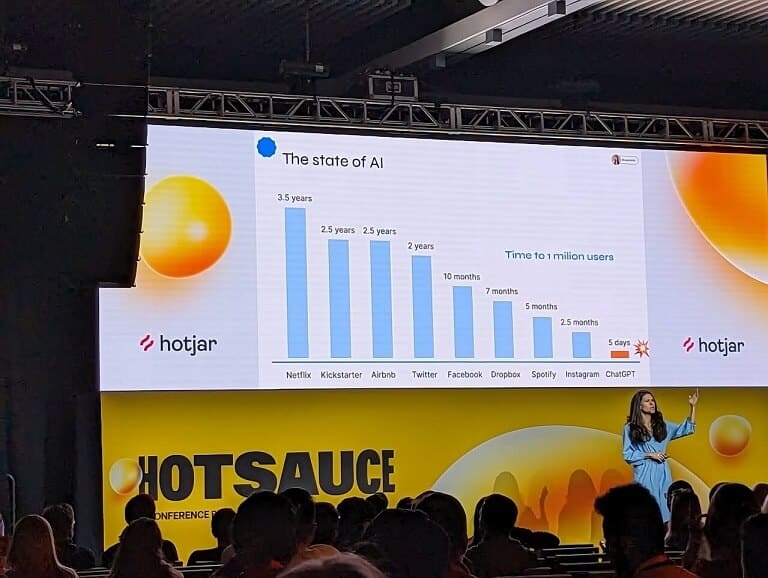
Ioana reiterated a timeless quote from John Culkin: “We shape our tools and, thereafter, our tools shape us,” prompting the audience to reflect on the responsibility that comes with designing AI systems. She delved into the challenges of AI design, from addressing inherent biases to ensuring safety, security, and transparency. The conversation on AI, she posited, should always be underpinned by the question of whether we should build a certain technology, not just whether we can.
Treating AI as a partner, not a usurper
Ioana presented a set of AI design principles that resonated with the room:
- Start with people
- Fight bias
- Give safety and control
- Build for everyone
- Be accountable
- Promote good
- Help people grow
- Build trust
- Age well
She proposed a future where hyper-personalization means each user will experience a unique version of the internet, a vision supported by context-aware interfaces and just-in-time products. Predictive analysis, customer support enhanced by AI, and the capacity for rapid iterative testing are just a few of the applications Ioana discussed
Addressing the common concern, “Will AI replace me?” Ioana responded with a resounding “No.” However, she warned that a person using AI will likely outpace those who don’t. While AI has the potential to be a powerful tool, it lacks the innate empathy and nuanced understanding of human needs, making the human designer’s role more critical than ever.
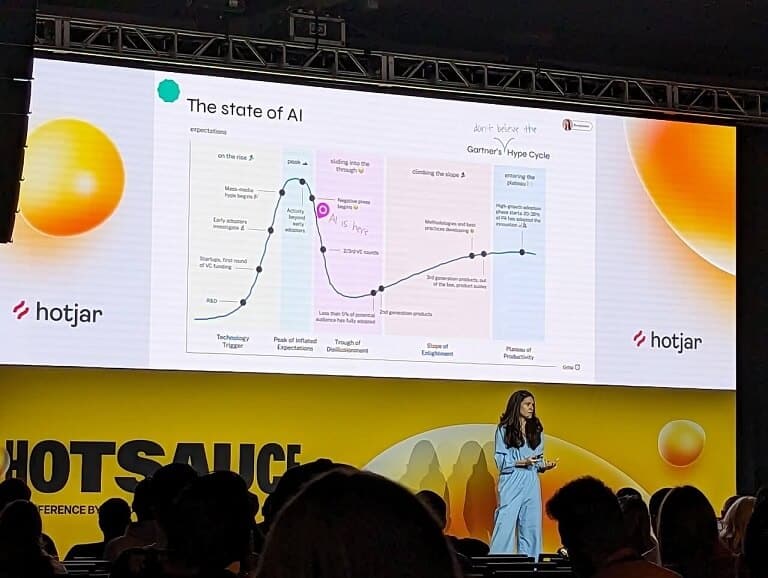
Ioana’s message was clear: AI should not replace humans but serve as an invaluable partner, enhancing our capabilities to innovate, create, and connect. As she concluded her talk, the audience was left with a sense of empowerment and a roadmap for integrating AI into their work in a way that stands out for its intentionality and impact
Following Ioana’s insightful foray into the potential of AI to enhance the user experience, the HOTSAUCE conference journey continued to explore the elements that drive users toward long-term engagement with products. The digital tapestry woven thus far had threads of empathy, innovation, and now, a new strand to bind them together: content.
How Content and Brand Can Accelerate Product Adoption with Ramli John
Stepping onto HOTSAUCE’s stage with an air of enthusiasm, Ramli John, content director at Appcues, and author of Product-Led Onboarding, prepared to dismantle the common afterthought that content trails in the user onboarding and product adoption process. His talk, How Content and Brand Can Accelerate Product Adoption, unfolded his three-part framework for leveraging content to convert users into brand champions.
Motivation: the content-powered boost
Drawing from the spirited world of Mario Kart, Ramli showcased how strategic content can serve as both a boost and a guide through the user journey. Just as players seek the speed-boosting strips on the racetrack, users look for content that accelerates their product mastery and enjoyment.
Ramli shared eye-opening statistics: users are searching for that ‘push’ in their experience, yet they are equally deterred by content that acts as a blocker, much like encountering a banana peel on Mario’s virtual racetrack.
Ability: enabling users to visualize success
The concept of ‘visualizing success’ struck a chord when Ramli demonstrated to the HOTSAUCE audience how invoicing application Wave allows users to personalize their invoice previews with their logos. This simplicity reduces cognitive friction and product friction, as it eases users into visualizing the product’s value in their lives.
Wave’s subtle yet compelling promise of getting users “paid 3x faster” exemplifies this principle in action, emphasizing how a clear value proposition is crucial.
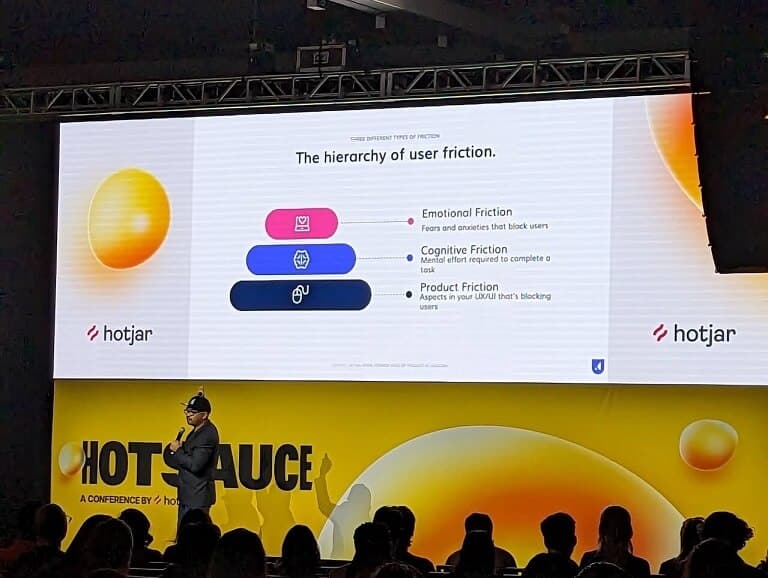
Prompts: timing is everything
Ramli underscored the importance of prompts – the content nudges that celebrate user wins or offer timely assistance. He noted that less than 5% of companies effectively employ this tactic.
Yet, when done right, as shown by CloudApp’s impressive 60-80% open rates on congratulatory emails, these prompts can significantly enhance user engagement. Canva’s prompts, encouraging users to maintain their creative momentum, are another excellent example of using content to not just celebrate current success but also to encourage continued engagement
The underlying message was clear: Can content be used as a lever to boost momentum and drive product adoption? According to Ramli, not only can it be used, it should be a pivotal part of the strategy in product-led growth
As we pondered Ramli’s insights, it became clear that the marriage of content and technological innovation is pivotal. With each statistic and real-world example, Ramli painted a vivid picture for the HOTSAUCE crowd: content is the voice of your product, capable of guiding, motivating, and celebrating the user at every turn. His talk left us with a resonant question: how will we craft our content to not just speak to our users, but to embark on the journey with them?
Creativity-Led Growth: The New, Authentic Way to Grow Your Biz with Kevan Lee
Riding the wave of energy from Ramli John’s spirited discussion on content’s role in product adoption, we pivoted to a talk that would once again recalibrate our understanding of business growth. Kevan Lee, Co-Founder of Bonfire, was set to unravel the tapestry of creativity in today’s marketplace. His topic, Creativity-Led Growth: The New, Authentic Way to Grow Your Biz in 2024, promised a dive into the heart of what makes brands truly resonate with their audience.
Kevan stepped onto the HOTSAUCE stage, his presence an embodiment of the creativity he was about to champion. He argued passionately for creativity as not just an aesthetic value but as the core driver of business growth, urging us to invest in it for tangible short-term gains.
Highlighting the bold move by Liquid Death—a canned water company—Kevan recounted how they spun negative feedback into a wildly successful campaign. They hosted a public blind-tasting event, humorously pitting their water against the “taste of licking someone’s sweaty back.” Thankfully, most participants preferred the water, and the stunt was a memorable win for creativity in marketing
He laid out what a creativity-led growth approach feels like:
- Authenticity: It’s about being true to your brand’s essence.
- Empathy: Understanding and connecting with your customers on a deeper level.
- Differentiation: Stand out by being boldly creative.
Kevan challenged the room, questioning why, amidst the myriad growth strategies like community, product, customer, sales, hunches, marketing, and founder-led growth, we shouldn’t pivot to creativity-led growth.
Unpacking the principles of creativity-led growth
- Understand your why: Kevan introduced the Ogilvy agency framework, a Venn diagram to uncover ‘The Big Ideal’ — the sweet spot between cultural tension and your brand’s best self.
- Research and expertise: He emphasized knowing your customers intimately, backed by a quadrant of research methods: quantitative and qualitative, focused both on customers and the broader audience.
- Embrace constraints: Creativity thrives within the confines of channels, budgets, and skills. Constraints are not hurdles but catalysts for innovation.
- Ditch the playbooks: Citing Warby Parker’s tech-centric approach that defied the traditional retail model, Kevan highlighted the power of a playbook-free zone, supported by a stat that companies with creative leadership outperform revenue expectations by 67%.
- Human touch: He pointed to Wendy’s social media success, where human wit and spontaneity fuel brand creativity.
Where to start and how to measure creativity’s impact
Kevan’s advice was straightforward: begin by outlining your narratives, and launch with a single campaign or idea. Measuring, he stressed, should be about learning, not judging. To underscore the importance of investing in brand creativity, he shared measurable dimensions of brand storytelling, such as brand awareness, customer loyalty, and conversion rates.
He also introduced an investment model to consider: the 70/20/10 rule, suggesting we allocate resources in that ratio to ‘Now’, ‘Next’, and ‘Later’ projects, fostering a balanced approach to immediate and future growth.
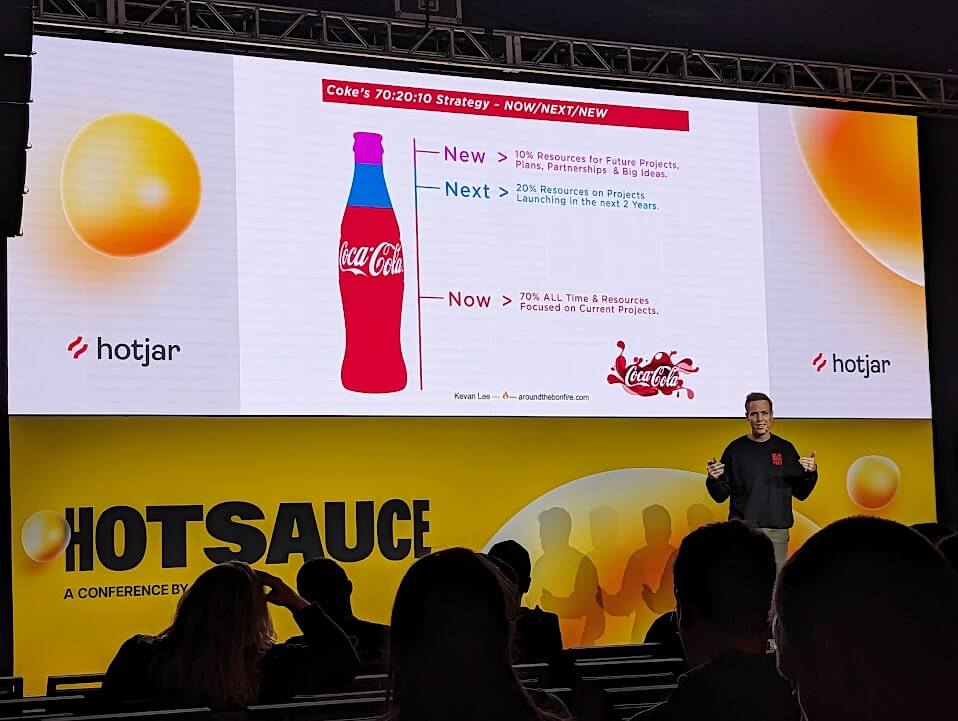
Advocating for creativity in the workplace
To foster more creativity at work, Kevan advised returning to the principles and showing proof points from past successful campaigns, broader market plays, or initiatives from admired companies
He concluded with an empowering reminder: “Everyone is creative. Creativity can and will drive business impact for you. I hope it’s something you invest in, in 2024.”
As his HOTSAUCE session wrapped up, Kevan left the audience buzzing with the possibility that embracing creativity might just be the most authentic way to propel their businesses forward in the ever-evolving landscape of 2024.
Driving Strategic Product Prioritization: Best Metrics and Processes with Ghazal Badiozamani
Fresh from Kevan Lee’s invigorating talk on creativity in business, the HOTSAUCE conference room was abuzz with ideas ready to be funneled into action. Next up, Ghazal Badiozamani, the Chief Product Officer at Catchafire, addressed a persistent pain point for product aficionados: strategic product prioritization. Her talk, Driving Strategic Product Prioritization: Best Metrics and Processes, was set to demystify the complex and often daunting task of product planning.
Ghazal began by acknowledging the wisdom of industry thought leaders. Marty Cagan emphasized the need for a strong point of view, Teresa Torres championed constant customer connection and evolution, and Spotify introduced us to the power of autonomous, cross-functional teams. Yet, Ghazal pointed out the fallacy in Spotify’s approach when they organized teams around functionality. “It’s not that great,” she said candidly, dismissing the model that often leaves engineers feeling compartmentalized and uninspired.
She brought up a common tool in strategic management — Objectives and Key Results (OKRs). Ghazal professed her love for OKRs but highlighted a crucial misstep organizations often make: trying to retrofit initiatives to meet these objectives, rather than letting the goals guide the product strategy. She projected a slide depicting a roadmap and team allocation gone awry, eliciting knowing nods from the HOTSAUCE audience.
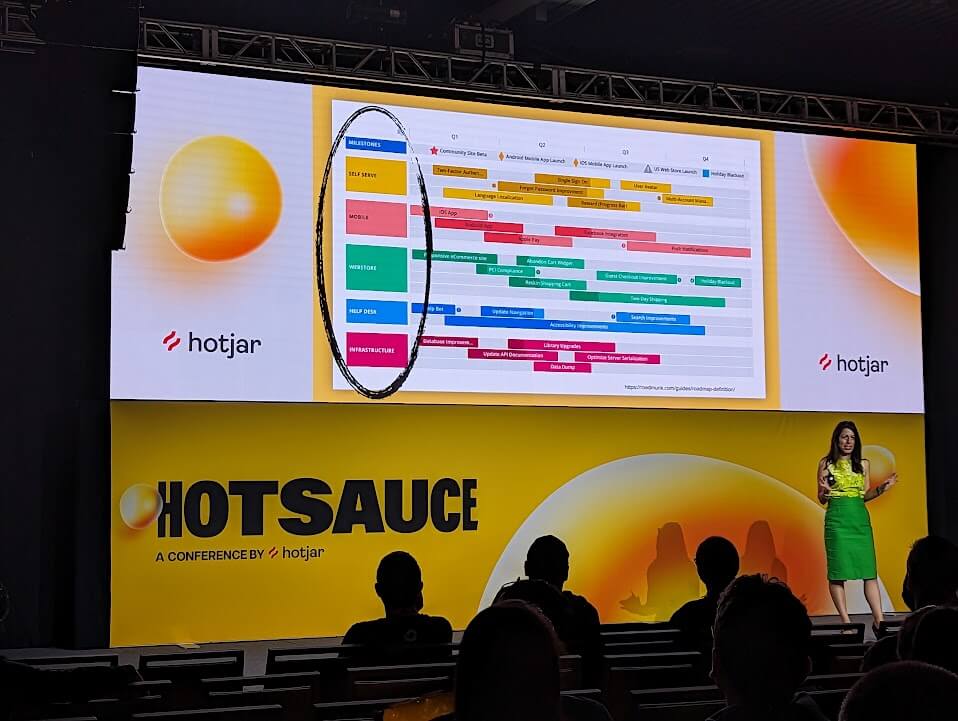
Reframing product strategy as business strategy
Ghazal offered a compelling reframing: product strategy is not merely aligned with business strategy; they are one and the same. “You are what you build,” she declared, urging leaders to view and manage goals like a portfolio, and build teams aligned with those goals.
Empowering teams through autonomy and alignment
With striking conviction, Ghazal proclaimed the marvels that autonomy can achieve when teams are aligned with outcomes rather than features. Autonomy leads teams to collaborate, experiment, and “kill early,” resulting in clearer business alignment, more innovation, and — crucially — happier engineers. When the focus shifts from features to metrics that align with company goals, teams are galvanized to work on what truly matters.
Articulation and transparency in decision-making
Ghazal underscored the importance of transparency in how decisions are made and goals are allocated. By clearly articulating the decision-making process, the conversation shifts from features to outcomes.
She acknowledged the feature-focused enthusiasm of some CEOs or board members, conceding that while some features are table stakes, they should be integrated within the broader goal-oriented framework.
An operating system for team alignment
Ghazal’s vision was for an ‘operating system’ that aligns teams with outcomes, providing an outcome-based roadmap that guarantees clarity and contentment within teams, ultimately leading to business victories.
As Ghazal concluded, her message was clear: the way forward in product prioritization is through a goal-centric approach that empowers teams, aligns with the overarching business strategy, and embraces transparency. This approach not only promises a smoother journey but also a more fruitful destination for product teams and businesses alike.

Product Lessons from the Happiest Place on Earth with Gabrielle Bufrem
As we shifted gears from strategic frameworks to the magical realm of user experience, Gabrielle Bufrem, a seasoned CPO and Product Leadership Coach, took the stage. Her talk, Product Lessons from the Happiest Place on Earth, promised to sprinkle a little fairy dust on our perceptions of product development.
Gabrielle was poised to reveal why crafting a product should be akin to orchestrating a Disney experience. She shared her “magical lessons” – deliver standout experiences, engage users when they’re already enjoying your product, simplify their decisions, and ensure upgrades feel natural and advantageous.
The inspiration for her HOTSAUCE session sparked while she navigated the winding queues at Disney, mesmerized by the effort poured into enchanting users at every turn. She drew parallels to product design, where delight should be the undercurrent of the user journey. “Think about the gift shops at the end of a Disney ride,” she said, “You exit through a playground of memorabilia, tempted to take a piece of the magic home – it’s a pretty amazing flywheel.”
Crafting the ‘obvious’ experience
But as Gabrielle pointed out, what seems obvious is rarely easy to achieve. She illustrated this with Universal Studios and Disney’s intuitive park planner apps, which make navigating the joyously overwhelming parks a breeze. From ride line limit notifications to route planning, everything is designed to let you simply enjoy the experience.
Understanding user needs and desires
To find your product’s ‘fast pass’ or ‘park planner’, Gabrielle urged the importance of truly knowing your users. She explained how Universal’s decision to split the Harry Potter world across two parks, although a business move, enriched the user experience by offering the delightful Hogwarts Express ride only to dual park ticket holders.
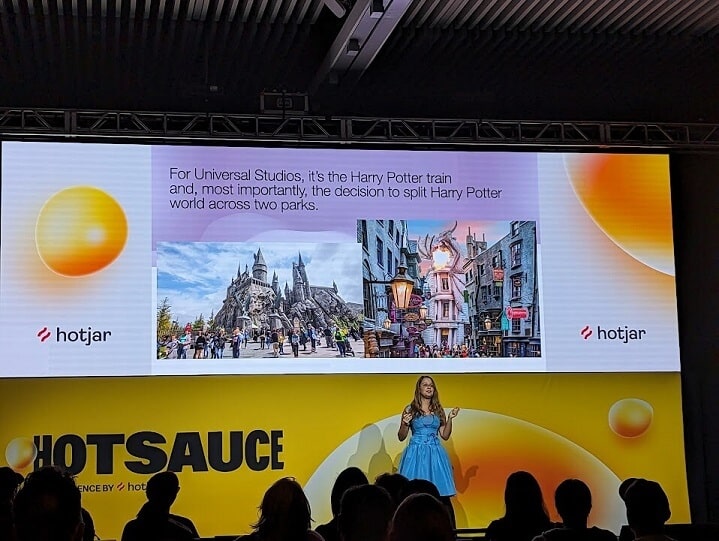
The magic of value intersection
She emphasized that your product must intersect user value with business value, highlighting Disney’s Magic Band as a case study. This innovation exemplified how a business tool, when designed to prioritize user delight, can revolutionize an experience while serving the company’s needs. “It’s a seamless blend of magic and utility – a frictionless experience that subtly nudges users towards choices that are good for them, and good for Disney,” Gabrielle explained.
Beyond products to experiences
The key takeaway was the need to align business and customer interests to create winning experiences. Gabrielle’s parting wisdom was a reminder to look beyond our screens and dashboards for inspiration. “To end on a magical note: Inspiration comes from literally every experience. This entire talk came from standing in line. Your next inspiration will not come from looking in Jira.”
As the HOTSAUCE attendees left, heads filled with visions of their products as the next source of delight for users worldwide, it was clear that Gabrielle had imparted a bit of the Disney spark into the world of product management.
The Unsung Influence of Pricing and Packaging to Drive Growth with Kyle Poyar
In the midst of the HOTSAUCE conference’s forward-thinking dialogues, Kyle Poyar took center stage to unravel the intricacies of pricing and packaging—a tandem that he believes is instrumental in understanding your audience and driving growth. Kyle, an Operating Partner at OpenView, was quick to debunk the myth of a perfect pricing strategy, instead advocating for a culture of iteration and continuous improvement.
“There’s no perfect pricing,” he declared, “You can iterate on it.” This came alongside a somewhat shocking statistic that only 6% of companies feel their pricing aligns perfectly with the value their product delivers.
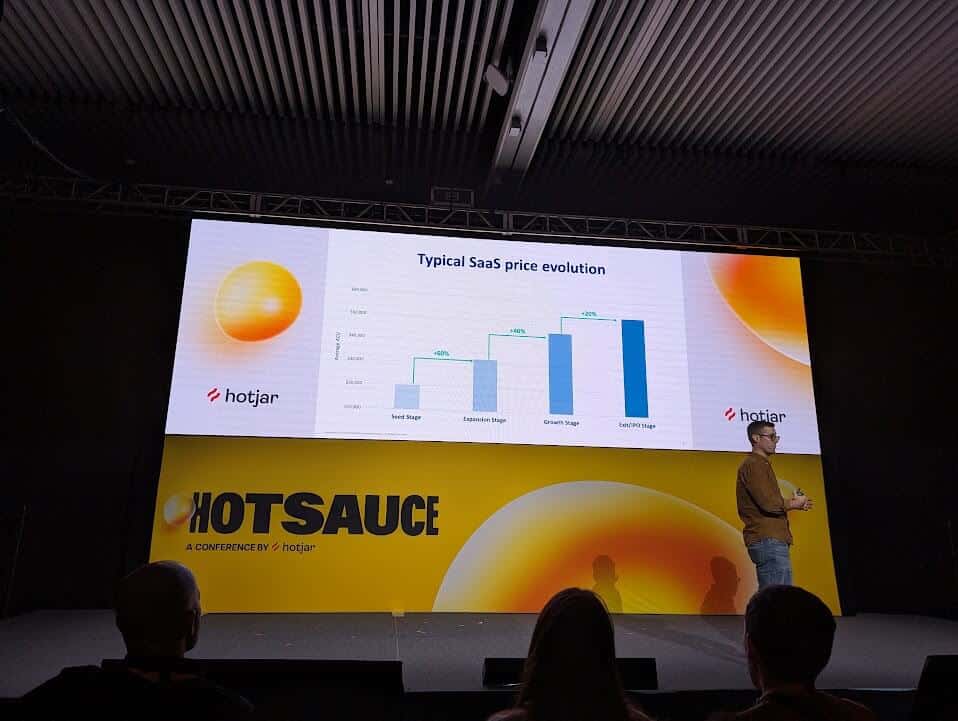
Kyle presented the audience with what he termed the “Top 5 pricing mistakes,” laying out not just the pitfalls but also the strategies to circumvent them:
1 – Being too cheap
Underpricing is a common faux pas. Kyle stressed that a company should revisit its pricing at each stage of its evolution. With each transition—from seed to expansion to growth stages—successful SaaS companies typically ramp up their pricing significantly. Neglecting this could mean leaving money on the table. And fear not, he added, as studies show there’s only a 2% chance that a price increase could negatively affect your ARR.
2 – Picking the wrong value metric
Kyle argued that the value metric is even more pivotal than the price point itself. It’s the unit of measure that captures the customers’ perceived value for your product and how they are charged for it. To nail this down, companies must connect deeply with their buyers, understanding their desired outcomes, buying preferences, and the scale at which they deepen product adoption over time.
3 – Making it hard to buy
According to Kyle, the shift toward a consumer-style buying experience, even in B2B, is changing the pricing game. He spotlighted Slack’s freemium model as an exemplary approach, allowing broad usage to fuel conversions. Kyle proposed a “Reverse trial” model—starting users with full features before downgrading—to enhance sign-ups and engagement.
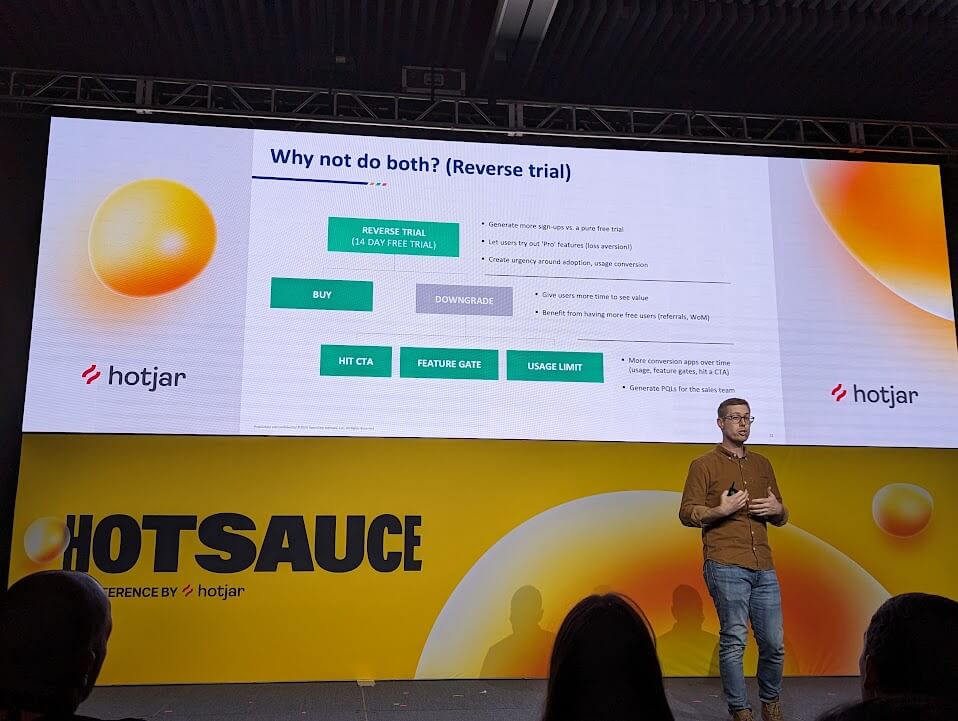
4 – Having a broken upsell path
Kyle underscored the importance of feature packaging and usage-based pricing as keys to achieving net negative churn. He pointed to HubSpot’s pivot from traditional tiered pricing to a usage-based model, which was pivotal in their journey to an IPO, showcasing how this strategy dramatically improved their NRR.
5 – Having static pricing
Finally, Kyle highlighted the importance of pricing evolution. From the simplicity of a seed-stage company’s single product offering to the complex segmentation and packaging at later stages, pricing should never remain static. Yet, a shockingly low number of companies engage in in-depth pricing research or multiple rounds of testing, missing out on potential growth opportunities.
Closing out his session, Kyle posed a challenge to the audience to determine who within their organizations should take ownership of pricing. With marketing, product, finance, sales, and operations all viable contenders, he stressed the importance of not where it lives, but that it has a clear owner.
As for timing, Kyle suggested looking for certain signals that indicate the readiness for a pricing overhaul, such as customers buying too quickly, usage outpacing spend, or significant product value additions without a pricing reevaluation.
As his talk on pricing strategies concluded, it was clear Kyle had laid out a blueprint for growth through strategic pricing and packaging—a roadmap for businesses to not just chase but to achieve exponential growth.
Inspiration ignited: closing reflections on HOTSAUCE’s premiere event
As the digital panorama of HOTSAUCE fades into the rearview, I find myself energized by the sheer scope of what we’ve explored and the connections we’ve made. Whether it was Gabrielle Bufrem infusing her product lessons with the magic of the happiest place on earth or Ghazal Badiozamani unraveling the intricacies of strategic product prioritization, each speaker at HOTSAUCE contributed to the larger narrative of innovative growth and the relentless pursuit of excellence.
A heartfelt shoutout to Christian, Nicole, Adrià, and the rest of the Hotjar team for orchestrating such an enriching event. Your dedication to creating a space for learning, networking, and growth did not go unnoticed. It was a pleasure to witness the seamless execution of the event, the carefully curated talks, and the fostering of an environment where ideas could truly flourish.
Although my notebook didn’t capture every golden nugget of wisdom shared, the experiences and lessons I’ve taken away are indelible. To all my fellow attendees and those I missed in the whirlwind of those action-packed days, let’s continue to challenge the status quo, embrace the shifts in our digital landscape, and apply the kernels of wisdom we’ve harvested from HOTSAUCE’s inaugural blaze of glory.
Until next time, let’s keep the sauce simmering and the ideas flowing!

